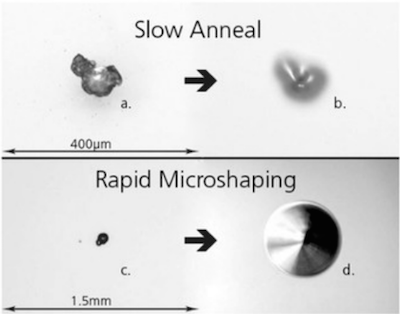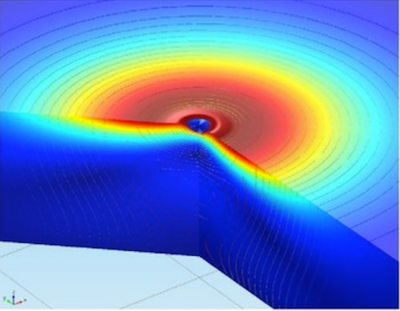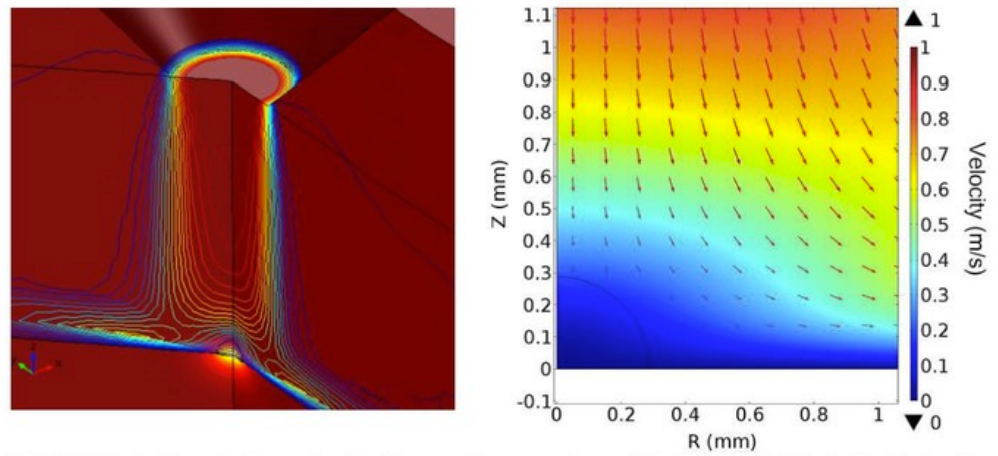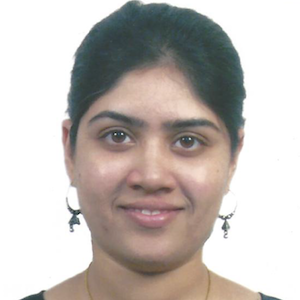
Lasers, focused beams of photons of a single wavelength, find use in a wide variety of applications today — from noninvasive surgeries and fiber optic communication to material processing and even DVD players. Let’s see how a research team from Lawrence Livermore National Laboratory (LLNL) used the power of multiphysics simulation to investigate laser-material interaction to avoid the damage of optics internal to high-power laser systems.
Laser-Induced Damage (LID) to Inherent Optics
Researchers at the Lawrence Livermore National Laboratory (LLNL) work to understand the complex interactions of lasers with materials. LLNL is in charge of the National Ignition Facility (NIF), which houses the world’s largest and most energetic laser. This machine can amplify optical energy to astronomical proportions and is used by astrophysicists to better understand the universe and nuclear fusion.
However, the demanding operating conditions of this laser take a toll on the internal/inherent optics that focus, reflect, and guide the laser beams. Repeated use of the laser causes damage to these optics, leaving microscopic dents and chips, as shown below. This damage, if not corrected, could alter the laser’s optical properties and as a result, the functional abilities of the laser, specifically leading to unwarranted light modulation and scattering. At the same time, these optics are expensive and replacing them repeatedly is uneconomical for the project.

Examples of optics damaged by repeated exposure to high-peak-power laser pulses. Damaged optical surfaces are shown on the left and the corresponding repair sites are shown on the right.
Small lasers can address the potential issue of laser-induced damage in the internal optics. A team of researchers in the Materials Science Division at LLNL, led by Manyalibo Matthews, focuses on innovative techniques for repairing these optics. With the help of simulation, they are exploring IR pulsed microshaping, thermal annealing, and laser chemical vapor deposition (L-CVD).
Multiphysics Simulation Offers a Solution
The first step in the simulation research was to understand the behavior of fused silica when exposed to a laser beam at varying temperatures. The team used the built-in capabilities of COMSOL Multiphysics to simultaneously simulate multiple physical phenomena, such as fluid flow, heat transfer, mass transport, structural mechanics, and chemical reactions.
The team started out by simulating the thermomechanical response of fused silica glass up to 1300 K (i.e., the glass transition temperature), then modeling structural relaxation and viscous flow at higher temperatures. Finally, they explored the evaporation and redeposition of the material at temperatures between ~2200 and 3400 K. This helped them understand the mechanical response of fused silica glass and how it behaves at extremely high temperatures.
The Infrared Micromachining Process
The researchers observed that at high temperatures, the flow of glass causes ripples that interfere with the optical properties, as shown below. They used very short-duration IR laser pulses to take away these defects, leaving behind a smooth surface.
Using COMSOL Multiphysics, the team was able to understand energy coupling and heat flow for a wide range of parameters, such as the duration of laser pulse (i.e., microseconds compared to minutes), and their results were in line with experimental observations. These simulation results also helped the team understand the material and temperature behavior in the laser-ablated regions. This knowledge can be applied to many other fields that involve the polishing, annealing, and microshaping of silica surfaces, such as optical glass polishing, as well as for medical and tribological applications.

Simulation results showing the Marangoni flow of the laser-heated glass. The Marangoni effect occurs when laser heating leads to gradients in temperature-dependent surface tension, which cause the material to flow radially outward, forming what look like ripples or rimmed pits.
Simulating Laser CVD for Larger Defects
To study larger defects in the optical system, the researchers at LLNL explored the applications of L-CVD. This additive process uses a silica precursor gas coupled with a CO2 laser beam to deposit material on the damaged surface with nanoscale precision. The precursor gas flows through a nozzle onto the optic surface along with the laser beam. The beam then decomposes the gas and deposits solid SiO2 on the damaged optic surface. Although this technique is still in its early stages, it shows great promise. Using COMSOL Multiphysics to optimize beam intensity, position, and pulse duration along with flow and concentration of deposited material, the team has made considerable progress toward understanding the various factors that influence L-CVD and addressing future additive damage repairs.

Velocity and temperature fields for L-CVD, showing the velocity contours associated with the precursor flow (left) and the velocity streamlines of the vaporized silica (right).
Reaping the Benefits of a Model-Based Approach to Laser-Material Interaction
Around 130,000 damage sites in the NIF laser have been repaired using IR microshaping, which was optimized in part using the researchers’ multiphysics simulation results. This has enabled the recycling of optics and a large cost reduction in the project. The team at LLNL also supports a lab-wide additive manufacturing initiative for 3D printing, which potentially has even more far-reaching applications than the repair of damaged optics.
Further Resources
- Access the full story of how LLNL uses simulation on page 17 of COMSOL News 2015
- Read an article on the research presented in this blog post:
- M.J. Matthews, S.T. Yang, N. Shen, S. Elhadj, R.N. Raman, G. Guss, I.L. Bass, M.C. Nostrand, P.J. Wegner, “Micro-Shaping, Polishing, and Damage Repair of Fused Silica Surfaces Using Focused Infrared Laser Beams“, Advanced Engineering Materials, 17, 2015, p. 247.
- Check out a related blog post: Modeling Laser-Material Interactions in COMSOL Multiphysics
- Browse the COMSOL Blog to see how other industries use the simulation capabilities of COMSOL Multiphysics




Comments (2)
Lyubo
July 13, 2020How can I simulate that?
Gaetano Lanzalone
July 26, 2020Hi,
I am still a beginner, and I would like to understand how to perform this simulation of a laser of 532nm or 1064nm wavelengths on different surfaces of silicon or silicon carbide.